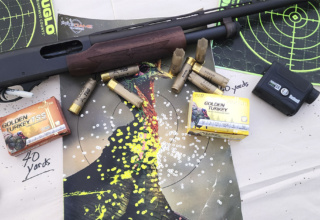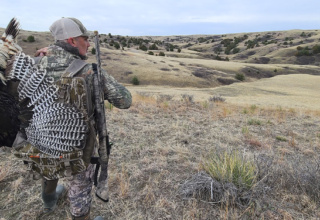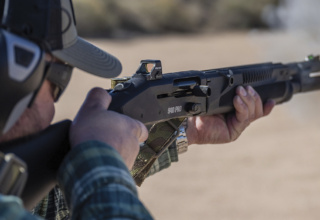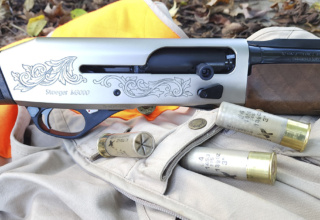Let’s cut through the speculations, assumptions, hearsay, and unreliable characters to find the choke that’s right for YOU.
by Larry Case
About this time every year, it starts. The question appears on turkey hunting forums, dreaded Facebook posts, and you hear it in discussions over there in the corner of the barbershop. It’s all about the same thing: “What is the best choke tube for my shotgun?”
Time was when a lot of us had one shotgun, and you used that gun for most everything. Going turkey hunting? Grab the scattergun. Rabbit hunting, a trip to the duck blind, running the crows out of the cornfield, or anything that didn’t require a rifle, we used that same shotgun. Times change. Now we not only may have different shotguns for different jobs, but the individual guns will have numerous choke tube choices.
Interchangeable, screw-in choke tubes are a modern wonder. The first screw in choke tube appeared about 1961 on Winchester’s revolutionary Model 59 shotgun. The Model 59 didn’t make it very long (I still don’t know why) and the choke tube didn’t catch on either, at least right then. Eight years later, Winchester trotted out the interchangeable choke tube on the Model 1200 and 1400 shotguns and, this time, it stuck. The choke tube was a hit and it wasn’t long (1978 for Mossberg and a few years later for Weatherby) before all shotgun makers were featuring screw-in tubes.
Turkey Hunters are Special
Whether you are a turkey hunter or not, you will have to admit we are a special bunch. Chasing crazy gobbling turkeys for a month or two in the spring, going without sleep, and sometimes pushing the envelope to stay employed and married is not good for anyone’s mental health. So, remembering this, it is not too much of a stretch to see that turkey hunters are a little different about shotguns and shells.
Once upon a time, most shotgun patterning was done on paper with a 30-inch circle at 35 yards. This was the standard. It is also when most shotgun shooting was done at flying targets—feathered and clay. A nice, even pattern within the circle was considered ideal to take down flying birds.
As spring gobbler hunting grew in popularity, turkey hunters were doing something different—they were sitting, not swinging the shotgun on a moving target; and they were aiming the gun at a stationary target (a turkey’s head and neck) like aiming a rifle.
This quickly evolved into turkey hunters no longer caring about that even pattern inside 30 inches. They wanted a dense, tight pattern at 40 yards and beyond…sometimes way beyond. Now, we have dozens of choke tubes and different turkey load shotshells to choose from, and we always circle back to that original question. What is the best choke tube for my shotgun?
How Do I Find the Best Choke Tube?
Well, there may not be just one. A fact of life you must consider, if you delve into this world, is this: the “best” pattern that you can get out of a shotgun is determined by a combination of three factors. Are you listening, class? Write this down. The three factors are the shotgun, the choke tube, and the cartridge (the ammo you fire for that test). If you change any one of those components, the pattern will almost always change, sometimes drastically.
Let’s address that “best” pattern for just a minute. What does “best” mean to you? In the turkey world, “best” has come to mean tight groups, usually the tighter the better. Turkey choke nerds have long done away with the 30-inch circle and now worship at the altar of the 10-inch sphere at 40 yards. For TSS shooters, over 300 pellets (#9 shot) in a 10” circle is not unusual and is demanded by many. Shooting #5s or #6s in lead, you will, of course, not get those kinds of numbers, and I am not sure you need them to kill turkeys, but it may be personal preference. Don’t forget, if you are shooting ultra-dense patterns at 40 yards and a gobbler appears at about 12 steps, you had better be aiming very carefully as your pattern may be roughly the size of softball at that range.
Just food for thought. Something closer to the old 30-inch standard may be in order.
Unless you want to spend all your disposable income on choke tubes (I’ve pretty much done that and don’t recommend it), I would suggest this: settle on one shotgun that you will use for turkey hunting. Maybe it’s a Remington 870, a Mossberg 500 or 835, or a CZ-USA Magnum Reaper…the choice is yours.
You may already have a certain turkey ammo shotshell that you like. Winchester Longbeard XR, Federal 3rd Degree, Fiocchi Golden Turkey, or Remington Nitro…again you decide. Pick a couple different brands and compare them with different chokes. Take some different chokes that you have, purchase a couple more, perhaps, and it’s time to go to the range.
Which Choke?
Deciding which chokes to put your hands on can be daunting. Are you going to shoot just lead? Are you going to venture into the TSS (Tungsten Super Shot) world, or maybe shoot a mixture of lead and bismuth? TRUGLO offers a good selection of turkey chokes to choose from that will not break the bank.
The Head-Banger Long Range Turkey Choke Tube – This is an extended choke that uses multi-phase groove technology to guide pellets into a tight pattern. The Head-Banger is rated for HEAVI-SHOT, Long Beard XR, and Federal Premium 3rd Degree as well as other high-performance turkey loads. The Head-Banger is made from heat-treated steel and is CNC machined for tight tolerances. When Remington produced their Turkey Pro version of the V3 shotgun, they chose the TRUGLO Head-Banger as the choke to be installed at the factory. They did this because the choke produced the best patterns with a wide variety of turkey ammo. I found this to be true in doing reviews on the V3. MSRP $58.99.
Strut-Stopper XTreme Choke Tube – The Strut-Stopper may be the tightest patterning choke of this trio from TRUGLO. The Strut-Stopper is the winner of 11 NWTF World Still Championships and 7 NWTF World Records. The Strut-Stopper will accept most turkey loads but is not recommended for steel shot. MSRP $42.99.
Gobble-Stopper XTreme Choke Tube – There may a reason that the Gobble-Stopper is the bestselling choke in the TRUGLO line. Many years ago, I bought a Gobble-Stopper choke and installed it on my Remington 870 Express. This gun and choke have been to many states and in the hands of many hunters over the years. Once, while on a gun writer hunt in Texas,the trail-worn 870 and the TRUGLO choke out-shot everything else that showed up that day. The duo then proceeded to knock over a couple Rio gobblers before they came home. The Gobble-Stopper accepts most turkey loads, including HEAVI Shot, and is endorsed by the National Wild Turkey Federation. MSRP $42.99.
The Range: Where the Rubber Hits the Road
For some reason, in our hunting culture, we seem to spend hours and lots of ammo trying to get tighter groups with a rifle, but many of us will not expend one shotgun shell on to find where our scattergun goes on paper. I think it is because most of us just assume all shotguns shoot the same when we point it at something.
[Buzzer sounding] WRONG!
Before we worry about how many pellets show up on a turkey target, we must determine two things: Point of Impact, and Point of Aim. The problem is, they are often not the same. To do this, start with low brass target-type loads—no need to hammer yourself with magnum turkey loads to find where we are on paper. Start at 20 yards. A large target backstop is better than a small one. That old 30-inch circle is great for this, so no need for turkey targets yet. Mark a small aiming point in the center of the circle. Do this shooting on a bench with a shooting bag and sandbags. You are “sighting in” the shotgun much like a rifle.
Carefully aim at the center of the circle, using an optic, beads, or open sights on the shotgun. Use the same aiming point each time you shoot. Shoot three rounds on the target and carefully study them. Is the pattern centered on the place you aimed at (aiming point) or is the pattern hitting in a different area (high, low, left or right)? If the pattern is hitting the paper (point of impact) different from where you aimed, then you must adjust for this. The easiest way, if you are shooting an optic, is simply adjust the optic as you would a rifle scope. If you are shooting a bead on the shotgun, it is not so easy. You either go to the gunsmith or you just allow for it in the field with Kentucky windage (if you remember to do this while facing a gobbler).
Once you know where you are on paper at 20 yards, go to 40 yards and do the same procedure. Now you can load a turkey load which you are considering hunting with and let fly. The point of impact may very well be a little different with the hunting load, but you can adjust accordingly.
Once you are comfortable with where the shotgun is shooting, now you can sort out a few choke tubes. Take a hunting load and run it through the prospective choke tube at 20, 40, and 60 yards (if you think you will shoot at a turkey at that range).
Finding the right turkey choke doesn’t have to be complicated. Match the gun, the shell, and the choke that you want to use and put it on paper. Now you can be confident when that big bird with the red, white, and blue head makes an appearance. You will also be able to make your argument better at the barber shop.





















